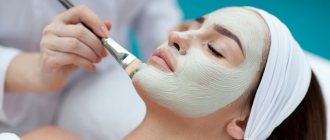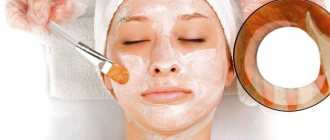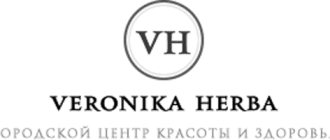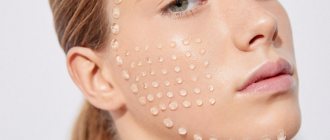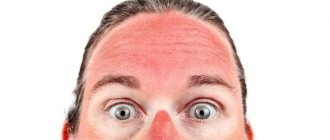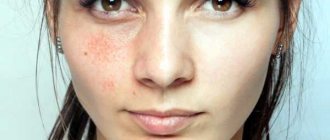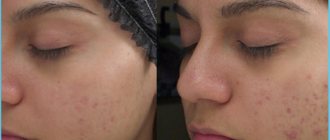A multifunctional chemical procedure, which is intended for all skin types and is highly effective, has received the loud name “Hollywood peeling”, or Jessner peeling.
According to experts, this technique is equally effective both for teenage acne and for improving complexion in ladies of “Balzac” age, even with fading mature skin without surgical intervention.
The final stage of proper rehabilitation is proper care of the treated tissues.
Possible consequences after a Jessner peel
An important feature of chemical peeling is not only the effect on all layers of the skin, but also the subsequent stimulation of the active process of cell restoration. Jessner peeling cares not only for the skin of the face, but also for the hands, décolleté, neck, and in some cases is used for the eyelids.
A wide choice of actions determines the presence of universal components in the peeling composition. It contains only 3 substances.
- Salicylic acid has a gentle effect on any kind of skin impurities, cleanses pores, dries them out, and helps to narrow them. Thanks to its anti-inflammatory and antiseptic effects, it soothes itching and provokes dead tissue to instantly shed.
- Lactic acid has a whitening and exfoliating effect. It promotes the production of collagen, a special protein that is responsible for the firmness and elasticity of the skin. Lactic acid, compared to other acids, has a softer and more gentle effect, therefore it has a beneficial effect on dry sensitive tissues. Its irreplaceable property remains the ability to retain and evenly redistribute moisture and concentrate it in all skin layers.
- Resorcinol helps to carry out the reaction of two acids: it enhances the whitening effect of lactic acid and the antibacterial process of salicylic acid, and has a cauterizing effect.
All components are used in 14% concentration. Sometimes the composition includes glycolic and citric acids, as well as isopropyl alcohol.
Depending on the dermatological problems present, the Jessner peel process may affect several layers of the skin:
- superficial procedure affects the outer stratum corneum, removing acne, improves complexion, gently exfoliating dead tissue;
- median peeling affects the basement membrane - the layer on which the epithelial layer is based, it can smooth out scars, reduce the depth of wrinkles, smooth them out;
- deep can replace a surgical facelift.
Another combined method of facial care is practiced during Jessner peeling - this is superficial-medium, when the cosmetologist alternates the depth of penetration.
Indications and contraindications
Chemical peels are useful in many cases. The combined composition is used for cosmetic and medicinal purposes. The procedure is required if:
- Wrinkles;
- Pigmentation;
- Skin defects (scars, scars);
- Eels;
- Fading skin.
The principle of renewing the epidermis with the help of substances that cause superficial burns of the skin significantly smoothes it out. If there is scarring on the skin, a course of several treatments will likely be needed. It is advisable to start it at the end of autumn. Among the contraindications:
- Inflammation in the active stage;
- Chronic infection;
- Postoperative period;
- Some diseases of the endocrine system;
- Pregnancy;
- Treatment with systemic retinoids;
- Skin damage;
- Herpes.
To get results, you must listen to the recommendations of cosmetologists.
Advantages of the technique
The Jessner method is absolutely safe. It does not cause complications because the solution does not penetrate into the deep layers of the skin. The epithelium sloughs off quickly and does not cause pain. Uniform exfoliation improves skin condition across the entire surface of the face. Already on the day of the procedure, you can feel the lifting effect of the procedure. Tight facial features bring pleasure and joy to any person.
Peeling can be recommended at any age and on any part of the body. In a short time, cosmetic defects that have been bothering you for years become invisible. By getting rid of scars, many people gain peace of mind and confidence. The session lasts several minutes. There is absolutely no need to take unplanned vacation. It is enough to coordinate with a specialist so that the most active days of peeling occur on weekends. You can also look great by getting rid of excess fat.
Chemical peeling solves many problems and requires little time. This is an alternative to Botox or lifting. The lack of global preparation and a short rehabilitation period allow you to do peeling at any convenient time and quickly return to the normal rhythm of life.
About the author: Larisa Vladimirovna Lukina
Dermatovenerology (Internship in the specialty of dermatovenerology (2003-2004), Certificate of the Department of Dermatovenerology of St. Petersburg State Medical University named after academician I.P. Pavlov dated June 29, 2004); Confirmation of the certificate in the Federal State Institution "SSC Rosmedtekhnologii" (144 hours, 2009) Confirmation of the certificate in the Rost State Medical University of the Ministry of Health of Russia (144 hours, 2014); approved clinical protocols. Read more about me in the Doctors-Authors section.
Specifics of the procedure
For surface cleaning, a special composition is applied in one layer. The middle one requires at least 3 layers of application, the drying time between which is at least 5 minutes. It is practically safe and is not accompanied by side effects in the form of scars.
Deep peeling is accompanied by simultaneous application of the composition four times.
Expert opinion
Elena Apostolyuk
Cosmetologist
Any chemical procedure involving acids is associated with damage to the epidermis. Most complications resulting from exposure to aggressive substances appear due to damage to the integrity of the skin, or are associated with the onset of an inflammatory process.
This is an inevitable and normal response of the body to mechanical intervention: redness and swelling appear, peeling is observed, and dark spots appear.
As side effects, acne may become more active, new comedones may form, and lumps may occur.
A professional will help determine the cause. Due to personal characteristics, the body may react with an allergic outbreak or exacerbation of a skin infection. In this case, the doctor prescribes treatment procedures using zinc-containing drugs and anti-inflammatory drugs.
The consequence of chemical peeling can be the formation of a burn on the skin. A similar phenomenon occurs due to a large number of applied layers, or in case of untimely removal of the composition with water.
A dense crust will “cover” the tissue until restoration. An ointment based on panthenol will help the skin cope with the consequences faster. At the same time, you need to take formulations that contain fatty acids and promote accelerated tissue healing.
How long the redness lasts after a Jessner peel depends on how intensively the chemical procedure was performed. During recovery after superficial exposure, uniform redness of the skin is observed for 1–2 days. With medium cleansing, facial redness persists for up to 5 days.
Peeling is typical for any chemical procedure. After visiting the salon, it lasts up to one week and indicates that the process of tissue renewal has begun. Typically, after a Jessner peel, the face begins to peel off on the 3rd day.
When this does not happen, this indicates that the skin is poorly susceptible to external irritants. If there is no peeling, the cosmetologist increases the number of layers applied during the subsequent session, and retinol is used as a mask.
Consequences in the form of peeling, redness of the skin, according to the time of their appearance, can be divided into:
- instant, which lasts up to 14 days;
- regenerating, appearing after 2.5–6 weeks;
- persistent changes formed after the process of cell restoration after 20–50 days.
To minimize undesirable consequences, it is necessary to pre-prepare the tissues for subsequent manipulations, as well as provide timely skin care after Jessner peeling.
Advantages and disadvantages
Jessner peeling, like any other cosmetic procedure, has positive and negative sides. The advantages include:
- safety;
- anti-inflammatory effect without complications;
- deep cleansing;
- can be used at any age;
- noticeable effect even after one session;
- when the skin peels, a person is not limited in his capabilities, so he can perform his usual work;
- short rehabilitation period;
- wide range of indications;
- acceptable price;
- takes no more than 20 minutes.
Jessner facial peeling is used only if the client is aware of the following disadvantages and limitations:
- contraindications (list above);
- the risk of complications remains;
- severe peeling when using a deep cleaning composition;
- unpleasant odor;
- As the number of layers increases, the duration of rehabilitation also changes in direct proportion.
How to care for your face after a Jessner peel, day by day
The rehabilitation process for facial care after Jessner peeling involves a minimal set of procedures. The recovery period for the skin lasts a week.
- During the first 7 days, you should not go outside without a high-protection UV cream. Avoid saunas, steam baths, and solariums for a long time.
- In order for redness after Jessner peeling to go away faster, you need to give up spicy, salty foods and alcoholic drinks, which provoke an excessive rush of blood to the capillaries. The same thing happens in the case of physical activity, so the question of whether it is possible to play sports after peeling remains closed. Excessive sweating can cause itching, which will interfere with normal skin restoration.
- To wash your face, use warm water and perform this ritual only after 10 hours after visiting the salon. In the first hours, you need to take care of your facial skin with thermal water.
- During the first 14 days after Jessner peeling, it is not recommended to use creams based on organic acids and alcohol-containing components. The skin becomes susceptible to temperature changes.
On the second day after superficial peeling, dead skin appears as small scales and looks like snow flakes. Deep peeling is characterized by the appearance of large white spots. On the second day, the face is covered with a thin film, which begins to peel off after 4–5 days.
Compound
The peeling product contains 3 active substances - resorcinol, lactic and salicylic acids in a concentration of 14%. They are selected in such a way as to simultaneously exfoliate dead cells, regulate the functioning of the sebaceous glands and stimulate the regeneration of the epidermis.
Salicylic acid is considered one of the most powerful antiseptics that can prevent the spread of infection. Lactic acid makes the skin softer and more elastic by accelerating collagen production. Resorcinol is necessary to enhance the effect of the two previous ingredients. In addition, it is used as a soothing agent that relieves redness. You can find out the indications and contraindications for the use of these substances from the table.
| Peeling component | Indications | Contraindications | Possible side effects |
| Salicylic acid | Rashes on the face, increased oily skin, open and closed comedones, post-acne (spots, shallow scars), hyperpigmentation | Individual intolerance to ethanol, pregnancy and lactation, infectious diseases of the epidermis | Itching and burning, swelling of the skin, temporary redness, burn |
| Lactic acid | Clogged pores, flaking skin, fine lines and wrinkles, loss of firmness and change in complexion, excessive oil production, age after 35 years | Acute herpetic infection, viral diseases (for example, ARVI), pregnancy and lactation, fresh tan, allergic reaction to the main component | Epidermal irritation, burning, itchy rashes and peeling are normal. Severe burns are possible if the solution concentration is incorrectly selected. |
| Resorcinol | Viral and infectious diseases of the skin, acne, impaired cell regeneration, prolonged itching | Intolerance to the component, childbearing and breastfeeding, deep wounds on the face (including burns) | An overdose of the substance can cause serious changes in the body, including dizziness, nausea and vomiting, and rapid pulse |
As you can see from the table, there are a lot of side effects. For this reason, choose a cosmetologist (or home peeling product) carefully.
What to put on your face
During the first 6 days after the Jessner peel procedure, decorative cosmetics should be avoided.
Expert opinion
Elena Apostolyuk
Cosmetologist
It is necessary to prepare the skin in advance. Before the procedure, use creams and lotions with fruit acids. This will help soften and adapt the epidermis to subsequent chemical exposure.
Care after a Jessner peel will be painless if you first consult with your doctor about the use of various remedies that will promote rapid recovery. Be sure to include moisturizer, sunscreen, and herbal oils during the rehabilitation period.
Complex care includes formulations with hyaluronic and pyrrolidonecarboxylic acid. To restore the skin and maintain mineral balance, the presence of amino acids, sodium and calcium is necessary.
What is salicylic peeling?
Salicylic peeling is one of the types of chemical peeling, which is carried out using salicylic acid of varying concentrations (it refers to BHA acids). Salicylic peeling does not damage the deep layers of the epidermis, so recovery will occur as quickly as possible.
One of the features of salicylic peeling is its effect. Dead cells are dissolved rather than scraped off, as happens with many other types of peeling. Salicylic acid breaks down the protein layers and causes exfoliation of the stratum corneum of the epidermis. As a result, the skin becomes noticeably cleaner, smoother, younger and more beautiful, comedones and blackheads disappear. With the help of peeling, you can lighten pigmentation, smooth out wrinkles, destroy pathogenic bacteria that cause acne and narrow pores.
To achieve the best results, it is recommended to combine salicylic peeling with other types of peeling, as well as various facial cleanses. The procedure perfectly helps to get rid of various inflammations, normalize the activity of the sebaceous glands, cleanse the skin, even out the complexion, smooth out the microrelief, smooth out facial wrinkles. Please note that after salicylic peeling, you cannot use cosmetics that contain zinc oxide and resorcinol.
What types of salicylic peels are there?
There are two types of salicylic peeling for the face: superficial and medium. Superficial peeling is carried out with acid, concentration from 15 to 20%. It is usually performed on young skin prone to acne and comedones. Superficial salicylic peeling has a refreshing, cleansing and antiseptic effect, reduces oiliness and porosity of the skin, and reduces the number of acne. Medium facial peeling with salicylic acid is carried out on the basis of 25 or 30% acid. Deeper cleansing helps fight the signs of age, smoothes wrinkles and helps lighten pigmentation.
The process of cell exfoliation occurs in different ways. The thinner your skin, the faster the exfoliation will occur. The exfoliation process is also affected by the acid concentration - the higher it is, the faster the exfoliation will occur. There are cases when peeling of the skin does not occur at all - it depends on the skin and how it reacts to the composition.
If after the salicylic peeling procedure swelling, blisters, hyperemia, and soreness of the skin appear, consult a specialist. As a rule, this is how individual intolerance to the drug or allergy manifests itself.




